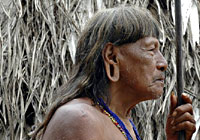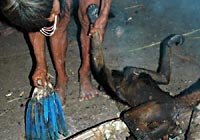
|
|
|
Amazon TribesIndigenous People of the Amazon RainforestBy Joel WestAmazon-Tribes.com is the ultimate source for information, resources, links and references on Amazon tribes, including photographs and videos of the indigenous people of the Amazon River Basin of South America. This website presents the various cultural traditions of Amazon tribes and Amazonian Indians in an enjoyable photo-essay format that allows one to view pictures of Amazon tribes with authoritative descriptions of their culture. Photos and images of these Amazon tribes natives ranges from Amazon Indian girls, Huaorani blowgun hunters, and female body painting, to Amazonian tribal warriors and uncontacted naked Amazonian tribes. In order to understand Amazon tribes and their significance, you must understand their history. Prior to the arrival of colonialists from Europe and first contact in sixteenth century, the Amazon River Basin had a population estimated at having up to a five million people and perhaps more than a five thousand Amazon tribes. However afterwards, the Amazonia experienced 500 years of violence, exploitation, and disease, that wiped out most of the original Amazon tribes. Presently, only about 500,000 Amazon Indians survive, which are distributed among an estimated 500 Amazon tribes, including about 75 uncontacted nude Amazon tribes living in voluntary isolation. Another important integral part of Amazon tribes that helps us understand their culture is language. Unlike Europe, where only one major language family exists (Indo-European), in the Amazonia their are 34 language families. Moreover, their are over a dozen language isolates spoken by only one Amazon tribe and that are unrelated to other languages. This represents an incredible cultural and linguistic diversity unseen any place else in the world. For comparisons, all of Europe, Africa, and Asia combined have just 21 language families. Therefore, just as the Amazon rainforest has the greatest biological diversity and species richness on the planet, Amazon tribes have the greatest cultural diversity and language richness in the world. The major language families of the Amazon tribes that presently exist in the Amazon River Basin include: Tupi-Guarani (70 distinct languages, including Kamayura (Kamaiura), Juruna, Cocama, and Cocamilla), Macro-Ge (32 known languages, including Kayapo and Suya), Arawakan (73 languages, including Machiguenga (somethimes spelled Machigenga or Matsiguenka), Yawalapiti, Ashaninka, Culina, and Guahibo), Yanomam (includes Yanomamö, Yanomami, Guaica, Guaharibo, and Guajaribo), Tucanoan (26 languages mostly in the western Amazonia, including Orejon and Secoya), Panoan (29 languages, including Conibo, Shipibo, Setebo, Cashibo, Capanawa, Juruá-Purús, Matis, Matses-Mayoruna, Marubo, and Korubo), Jivaroan (includes Candosi, Achuar-Shiwar, Aguaruna, Huambisa, and Shuar), Witotan, (includes Bora, Ocaina, and Huitoto), and Quechuan (although originally from the Andes, dialects are spoken by various Amazon tribes in the Amazonia, including Kichwa, Lamista, and Quecha from the Pastaza, Tigre, and Napo Rivers). In addition to the multiplude of language families among the Amazon tribes in the Amazonia, there are various languages among the Amazon tribes that are unrelated to all know languages, and these are referred to as language isolates by linguists. Examples of Amazonian language isolates are Ticuna (Tikuna), Waorani (Huaorani), Trumai, and Urarina (Shimacu). The Amazon tribes of the Amazon River Basin live in many different environments and have adapted their culture to the various ecosystems. While most Amazon tribes and Amazonian Indians live in the lush, tropical rainforests, some of the Amazon tribes exist in the grasslands and pampas (prairies), and some even live in semi-desert areas. Because of the varied environments in which they live, their material culture of Amazon tribes, which allows them to adapt and survive, varies greatly. In the warmer parts of the Amazon River Basin, most tribes were traditionally nude tribes with no cultural taboos of girls and women showing their naked breasts or of either sex displaying their nude body. Another interesting piece of information about these Amazon Indians is that, depending on the area in which they live and the particular Amazon tribe they belong to, they have had various influences by outside cultures. This would be expected in that the Amazon Rainforest area itself is divided among nine different countries (Brazil, Peru, Ecuador, Bolivia, Colombia, Venezuela, Guyana, French Guiana, and Suriname). An example of how outside contact and environment has influenced the various Amazon tribes is the Bororo tribe. The Bororo Indians live in the southern Amazon where the environmental conditions are dryer than in the north. Moreover, this Amazon tribe has been in contact with Brazilians for over a century. Consequently, they tend to speak Portuguese and have developed a material culture that is adapted to their semi-arid environment. At the other end of the spectrum are the uncontacted nude tribes in the Peruvian-Brazilian border area. The naked Amazon tribes in this area do not speak western languages such as Portuguese or Spanish and still live by traditional methods of hunting and gathering resources from the tropical Amazon Rainforest. In the last several years, uncontacted nude Amazon tribes have received considerable attention in the news and popular press. This has been due to the release by the Peruvian and Brazilian governments of spectacular photographs of naked uncontacted Amazon tribes in the border areas of Peru and Brazil. In September of 2007, Peru’s INRENA agency released photographs and video of a naked Amazon tribe living in isolation along the Las Piedras River inside of the Alto Purús National Park. Due to characteristic construction of their temporary shelters with palm leaves, they were identified as the Mascho-Piro tribe. Subsequently in May of 2008, the Brazilian government’s FUNAI agency released astonishing pictures of an uncontacted nude Amazon tribe with black and red body painting, wielding bows and arrows. It is estimated that at least 15 different Amazon tribes are living in voluntary isolation in Peru and that there are perhaps more than 45 uncontacted nude tribes in Brazilian Amazon. The most recent uncontacted naked Amazon tribe to make first contact with the outside world is the Korubo tribe. This Amazonian tribe is still living in a state of nudity, being naked and wearing no clothes whatsoever. Although most of the Korubo tribe is still living in voluntary isolation from the outside world, a small band of Korubo Indians have made contact. This naked Amazon tribe is known locally as the “Caceteiros” which means “clubbers” in Portuguese. However, the popular press began calling them the “head-bashers.” In their own language, they call themselves the “Dslala.” The Korubos are a nude Amazon tribe that speaks a language in the Pano linguistic family that is closely related to that of the Matis Indians. In fact, the Korubos have much in common with the Matis, both being primarily blowgun hunters rather than using bows and arrows. One difference, however, is the absence of facial tattoos that most other Amazon tribes in the Javari Valley possess, for example the Matis, Mayoruna-Matses, and Marubos.
Another excellent resource on Amazon tribes and Amazonian Indians can be found at
Amazon-Indians.org
whose mission is to help preserve the cultures of indigenous people from the Amazon Basin of South America. Additionally,
wonderful photos and information on native Amazon tribes can be found at
Amazonz.info,
Matses.info, and
IquitosNews.com.
For pictures and information on indigenous people (Quechua) and ancient Incas from the Andes Mountains of South America please visit,
IncaTrails.org, and
Camino-Inca.info.
To learn how you can help protect the indigenous natives of the Amazon Basin, please visit the
Friends of the Amazon.
For information and images of the native people of Africa, check out
African-Tribe.com.
|
|
Photographs of Amazon tribes from the 2007 Huaorani Expedition are courtesy of Jacek Palkiewicz. For more information about Jacek Palkiewicz, the explorer and discoverer of the source of the Amazon River, please visit his website at www.palkiewicz.com |




























